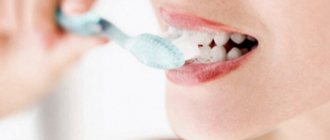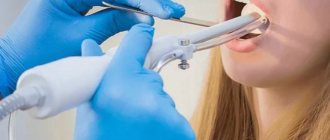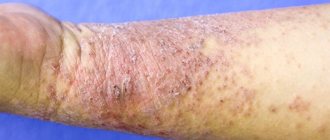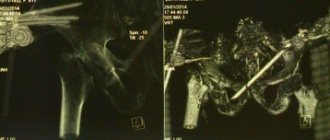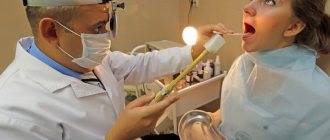Symptoms of a tooth abscess
The inflammatory process in the tissues of the tooth and gums occurs in stages and is accompanied by different symptoms:
- At the beginning of development, discomfort appears, slight swelling, gum bleeding is possible when brushing teeth, and pain is sensitive when pressed.
- In later stages, swelling increases, and a reaction to hot and cold foods appears. There is prolonged pain and an unpleasant odor. In addition to local changes, the abscess is accompanied by enlarged lymph nodes in the neck, increased body temperature, and general malaise.
A bitter aftertaste is noticeable in the mouth, and a change in the shade of the tooth body is possible. It is important to remember: the symptoms of gum abscess can manifest themselves in different ways - everyone has their own pain sensitivity threshold and perceives signals subjectively. Therefore, you should not wait for acute conditions; a reasonable step is to visit a dental clinic at the first incomprehensible sensation.
Diagnosis of sepsis
Timely diagnosis of sepsis is crucial for the patient’s recovery. The earlier treatment is started, the greater the chances of success. The diagnosis is made on the basis of clinical examination and laboratory and instrumental examination.
Clinical criteria:
- Body temperature is more than 38 degrees or less than 36 degrees.
- Heart rate is more than 90 or exceeds the age norm.
- Respiration rate more than 20 times per minute.
- Presence of edema.
- Confusion.
- An increase in blood glucose levels of more than 7.7 µmol/l in the absence of diabetes.
- Disturbance of hemodynamic processes - a decrease in systolic blood pressure of less than 90 mmHg, or its decrease by more than 40 mmHg. from the usual meaning. [5,6]
Laboratory criteria
A general blood test is performed with a leukocyte count and platelet count. In case of sepsis, leukocytosis is determined by more than 12*109/l or leukopenia when the number of leukocytes is below 4*109/l. There is also the release of immature forms of granulocytes into the bloodstream and a decrease in the number of platelets.
A biochemical blood test shows an increase in C-reactive protein, creatinine, and bilirubin. But these are nonspecific signs that can be observed in other diseases. Therefore, the search for more informative diagnostic methods continues.
Today, the main such markers are procalcitonin, presepsin, and CRP. Based on this laboratory indicator, a diagnosis is made and the dynamics of the disease are monitored.
Bacteriological culture
Detection of microorganisms in the blood is an important, but not mandatory, manifestation of sepsis. Even with the use of the most modern diagnostic systems and careful adherence to material sampling techniques, it is possible to isolate the pathogen from the blood in less than half of the cases. Therefore, a negative culture result in the presence of clinical symptoms should not be regarded as the absence of sepsis, and, conversely, the isolation of microorganisms from the blood in the absence of symptoms should be regarded as transient bacteremia or viremia, but not as sepsis.
However, biological studies should in any case be present as one of the stages in diagnosing sepsis for the following reasons:
- Possibility of determining the etiology of the pathogen.
- Selection or change of antibiotic treatment regimens.
- Monitoring the effectiveness of treatment.
- In some cases, it allows you to determine the source of infection, for example, catheter-related infection, endocarditis, etc.
Book a consultation 24 hours a day
+7+7+78
What complications can there be?
Even if the pain has dulled, the symptoms have become less pronounced, you should not postpone your visit to the dentist. This situation may be a signal indicating the death of the root and the further spread of infection to the organs of the head or neck.
The area cannot be heated. This approach will bring short-term relief, but will accelerate the formation of the fistula and stimulate the release of pus.
Possible serious complications: brain inflammation, pneumonia. There is a risk of sepsis, development of osteomyelitis, damage to the nasal sinuses or meninges.
Stages of sepsis development
The development and course of the septic process is individual and depends both on the properties of the pathogen and on the characteristics of the patient’s body. However, several phases of the course of this disease can be distinguished:
- Voltage phase. In response to the introduction of the pathogen, the body’s defense systems are activated and mobilized, in particular the pituitary-adrenal system is activated.
- Catabolic phase. The patient's condition deteriorates due to metabolic disturbances. The processes of metabolism of proteins, fats and carbohydrates are enhanced, and they are extracted from the “depot”. Disorders of water-electrolyte metabolism and acid-base status also develop.
- Anabolic phase. At this time, recovery processes begin. This primarily concerns structural proteins.
- Rehabilitation phase. During this period, further restoration of metabolic processes occurs. In some cases, complete recovery is not possible.
As for the duration of the disease, everything is again individual. In some, stronger patients, sepsis is relieved within 3-4 weeks, in others it can last for years, periodically subsiding and flaring up.
In addition, when diagnosing sepsis, the following conditions are distinguished.
Toxic-resorptive fever
Toxic-resorptive fever is a condition that develops when bacterial toxins or tissue decay products are absorbed from the primary pathological focus. As a rule, this is typical for bacterial infections of wounds, catheters, etc. There are common typical syndromes that accompany infectious processes - fever, changes in general blood and urine tests (leukocytosis, proteinuria). Once the primary lesion is eliminated, the patient's condition stabilizes.
Septicemia
Septicemia is a form of sepsis in which there is a pronounced intoxication syndrome, hyperergy (increased reactivity of the body) and a rapid course. Septic foci are either minimally expressed or absent. This form of sepsis is more typical for children in the first years of life. The clinical picture is more characterized by general manifestations:
- Hemolytic jaundice, accompanied by yellowing of the skin and sclera.
- Rash. It first appears as small pink dots, which grow and merge with each other, forming pale pink or purple spots.
- In some patients, elements of the rash may become blistered or ulcerated. With deep lesions, subcutaneous fatty tissue may be affected with the development of phlegmonous inflammation.
- Hemorrhagic syndrome - hemorrhages in internal organs.
Septicopyemia
Septicopyemia is a form of sepsis in which in the body, in addition to general intoxication, metastatic abscesses begin to appear in organs and tissues, which are the result of bacterial embolism. Most often, the first abscesses are found in the lungs, and then the process spreads to other organs: liver, liver, heart, meningeal membranes, synovial membranes. Abscesses can break through and cause the development of pleural empyema, phlegmon, peritonitis, etc.
Causes of dental inflammation
The main causes of tooth gum abscess and pulp infection:
- Advanced caries affecting the root apex. Suppuration develops against the background of periodontitis.
- Untreated gingivitis and periodontitis (gum disease). They often develop as post-traumatic complications: pathogenic microflora accumulates in periodontal pockets.
- Weakening of the immune system after illness (flu, sore throat, etc.).
- Iatrogenic factors - bacteria entered after the use of unsterile instruments during treatment, injections, or incorrect tooth extraction.
The development of the inflammatory process may be preceded by damage to the oral mucosa and the formation of boils.
Causes of sepsis
Sepsis can be caused by most microorganisms known in epidemiology, including bacteria, viruses (including seasonal influenza viruses), fungi, and parasites. Typically, the infectious agent enters the body from the external environment. Under certain conditions, for example, with immunodeficiencies, the disease can develop from the natural, opportunistic flora of the body, which is normally present in every person. [1]
The presence of infection in itself does not guarantee the development of sepsis. Additional conditions are needed that will lead to generalization of the process and a pathological response of the body. The likelihood of such events increases in the following cases:
- The patient's age is over 75 years.
- Performing surgeries or invasive procedures.
- Presence of injuries and burns.
- Immune system disorders - AIDS, cancer, chemotherapy, the need to use immunosuppressive therapy (for example, after organ transplantation), the need to take high doses of glucocorticosteroids.
- Long-term treatment in a hospital setting.
- Availability of catheters, cannulas, probes and other invasive devices.
- Pregnancy and childbirth.
- Chemical dependence - alcoholism, drug addiction.
- The presence of chronic diseases - chronic renal failure, respiratory failure, diabetes mellitus and much more.
Gram-positive and gram-negative sepsis
Depending on how bacteria are stained after treatment with special dyes, they are divided into gram-positive and gram-negative. Accordingly, sepsis, depending on the nature of the pathogen, can also be gram-positive and gram-negative, and this division plays an important role in clinical practice.
Among the gram-positive bacteria in sepsis, the most common are staphylococci and streptococci. These bacteria secrete exotoxins - proteins that disrupt important processes in human cells and poison the body. Staphylococcal sepsis in 95% of cases occurs in the form of septicopyemia, and streptococcal sepsis most often occurs as severe septicemia with dysfunction of internal organs.
Gram-negative sepsis is most often caused by Escherichia coli, Klebsiella, Proteus, Enterobacteriaceae, and Pseudomonas aeruginosa. These bacteria contain very powerful endotoxins. They differ from exotoxins in that they are structural components of bacterial cells and are released only after their death. The structure of endotoxins is lipopolysaccharides. They cause serious pathological changes in the human body:
- Increased production of cytokines - substances involved in the inflammatory process. A vicious circle can arise when the body produces a huge amount of cytokines, they activate immune cells, and they produce new cytokines. This condition is called a cytokine storm, and it can lead to the death of the patient.
- Necrosis (death) of cells lining the walls of blood vessels (endotheliocytes), and the formation of blood clots.
- Endotoxemia is poisoning of the body with toxic metabolic products.
- Multiple organ failure is a deadly dysfunction of all organs.
Gram-negative sepsis is usually severe. Septic shock often develops early on, and many patients die. Particularly dangerous situations occur when there is a nosocomial infection caused by multidrug-resistant bacteria (resistant to two or more different antibiotics).
What is sepsis and what is not?
To understand this issue, let's talk about some common misconceptions:
"Sepsis is an infection"
This is true, but only half. A person constantly encounters infections in everyday life. For example, you can touch a door handle in a supermarket that contains ARVI viruses, and then transfer them to the mucous membrane by scratching your nose. But this will not lead to sepsis. You will just get a cold, or in the worst case, the flu or COVID-19. Even within the normal microflora of the human body there are bacteria that, under certain conditions, cause dangerous infections and sepsis. However, for most people this does not happen.
If pathogenic bacteria enter the bloodstream, this condition is called bacteremia. But this is not sepsis yet.
Sepsis is a combination of infection and the body's overreaction to it.
“Most often people contract sepsis in the hospital because there are a lot of bacteria resistant to antibiotics there.”
Firstly, you cannot catch sepsis. Only some infections that lead to sepsis can be contracted directly from a patient. If your immune system is functioning normally, you will only develop the corresponding infection. Secondly, according to experts from the Sepsis Alliance (USA), in 80% of cases, sepsis develops in people who are not in a hospital.
“There are now many good antibiotics, infections are generally not dangerous, and sepsis is very rare.”
Despite the fact that modern doctors have many antibiotics in their arsenal, sepsis is still difficult to fight. For example, in the United States, it claims more lives each year than breast, prostate and AIDS cancers combined. The rise of antibiotic-resistant bacteria is a huge problem in modern health care. And in general, as we have already discussed above, it is not only about infections, but also about the characteristics of the immune response. Some people are at increased risk. For example, cancer patients.
Types of fungi
Candida are representatives of normal microflora. Several types of candida are known, which can also be pathogens. Fungal gastroenteritis is observed in severely weakened children and the elderly, as well as people of any age with significant immune deficiency of various origins. They are characterized by a gradual onset, bloating, infrequent loose foamy stools, rumbling and various soreness, nausea, vomiting, and cramping abdominal pain. In very severe cases candidasepsis may occur. Secondary infection easily develops on the affected surfaces. The disease is getting worse. Such a course of candidiasis is possible only in a dirty intestine, with blockages from a mixed meat and dairy diet in the body with a high deficiency of silicon, which is capable of excreting candida with feces. In practice, 90% of those consulted suffer from candidiasis.
Cryptococci - cause subacute or chronic deep mycosis. Most often (70%) this disease occurs in people with a mixed diet who have overloaded the enzymatic apparatus of the stomach. In such cases, even baker's yeast can cause cryptoccosis due to the infinitely large expenditure of acid to neutralize alkaline enzymes coming from the mouth with carbohydrate foods that were eaten along with protein. To get rid of this disease, it is necessary to remove the root cause of the disease - overload of the acid-forming gastric mucosal bioapparatus, use only separate nutrition, cleanse the intestines, and only then will antimycotic treatment be successful.
Penicildia - cause deep mycoses, caused by a variety of green molds that can affect the skin, mucous membranes, external auditory canal, and internal organs. Penicilliums occur after the use of antibiotics. Nocardia asteroides are aerobic, immobile formations that occupy an intermediate state between fungi and bacteria. Most are saprophytes, but can cause diseases in humans and animals. Nocardiosis can be expressed as mycetoma -. a tumor in the lungs consisting of a dense plexus of mold.
A close relative of Nocardia asteroides is Actinomycetes isrielii. They cause severe mycotic lesions of the cervicofacial region, chest and abdominal cavities - granulomas. This fungus is most often found in people living in areas of high radiation, as well as working in hazardous chemical production.
Mucor fungi cause a disease very similar to tuberculosis - mucophomycosis.
Aspergillus is a fungus that includes many species. Some of them are pathogenic. They are capable of deeply affecting tissues. They release toxins and give rise to malignant formations.
Geotrichosis is a disease caused by fungi that attack the mucous membranes. They accompany diseases - otitis media, sinusitis.
Trichophyton is a fungus that causes diseases of the skin, hair, and nails. It is rare to find a person who is not contaminated with trichophyton.
Trichophytis - causes ringworm disease. Trichophytosis can be superficial or chronic. Superficial trichophytosis is characterized by the appearance of erymatous peeling on the scalp. The fungus penetrates the hair, destroys it, the hair breaks, which is why the name “ringworm” is associated.
Epidermophyton floccosum is the causative agent of lichen nigricans. This disease manifests itself as slightly scaly dark brown or black spots, most pronounced on the extremities. Penetration of the fungus into the skin can be deep, and upon recovery, when the black spots disappear, the skin regains its ability to pigment (change color from exposure to the sun) for 2-3 years. At this time, non-tanning spots from ringworm black appear on the arms and legs. The disease recedes with the usual antimycotic treatment with celandine juice.
Microsporiums are fungi that cause the disease microsporia, which affects the skin, hair and nails. Exposure to all kinds of creams, ointments, powders and rubs either does not give a healing effect, or gives a very short-term improvement in health. To completely get rid of microsporia, it is necessary to take antimycotic treatment from inside the body.
Mycosis fungoides - causes the disease mycosis fungoides - a malignant tumor lesion of the lymph vessels, the fungus initially settles on the skin, and then colonizes the lymphatic system.
Mycoplasmas Fluor - cause inflammatory processes mainly in the respiratory organs and in the genitourinary system.
Sporothrix is a fungus that attacks muscles, bones, and internal organs.
All fungi produce poisons that cause a wide variety of allergic reactions. Toxins from aspergilus fungi have a toxic effect on the liver.
Yeast species: Candida, Candida albicans, Cryptococcus, Trichosporum, Saccharomyces.
Molds: trichophyton, microsporium, epidermiphyton, aspergillus, mycosis.
Tooth flux - what is it?
Periostitis (flux) is a rather unpleasant process that affects soft tissues and periosteum. An inflamed pouch on the gum can form after unprofessional treatment by a dentist, as a result of injury to the mucous membranes or as a consequence of their disease. There are different forms of flux, differing in the localization of inflammation. For example, with serous periostitis, the periosteum becomes inflamed, and infection with diffuse flux affects different parts of the jaw, so the pathology has to be eliminated surgically.
Key Recommendations
A. Initial therapy of sepsis
- Sepsis and septic shock are medical emergencies and therefore initial therapy and resuscitation measures must be started immediately! (best practice guideline – BPS).
- Patients with hypoperfusion should receive at least 30 mL/kg intravenous crystalloid solutions during the first 3 hours of resuscitation (strong recommendation, low-quality evidence).
- Subsequent additional fluid resuscitation is adjusted based on frequent reassessment of hemodynamic status (best practice recommendation - BPS).
- Further assessment of the patient's hemodynamics (eg, cardiovascular function) to determine the type of shock is recommended when the clinical picture does not lead to a clear diagnosis (best practice recommendation - BPS).
- In patients with signs of septic shock who require vasopressors, the initial target mean arterial pressure (MAP) should be 65 mmHg. Art. (strong recommendation, moderate quality of evidence).
- Dynamic hemodynamic parameters, as opposed to static ones, can be used as a predictor of response to fluid therapy, where possible (weak recommendations, low quality of evidence).
- Resuscitation efforts should also aim to normalize lactate levels in patients with sepsis/septic shock, as a major marker of tissue hypoperfusion (weak recommendation, low-quality evidence).
B. Screening for sepsis and improving its quality
- It is recommended that hospitals establish a program to improve the quality of care for sepsis, which would include screening for sepsis in patients with severe illness and in high-risk patients (best practice recommendation - BPS).
C. Diagnosis of sepsis
- Microbiological culture samples (including blood) should be obtained before initiating antibacterial treatment in patients with suspected sepsis/septic shock; as long as it does not significantly delay the initiation of antimicrobial therapy (best practice recommendation - BPS).
D. Antibacterial therapy
- Intravenous antimicrobials should be started immediately after identification of the causative agent and/or within 1 hour of the first symptoms of sepsis/septic shock (strong recommendation, moderate quality of evidence, assessment applies to both conditions).
- Empiric antimicrobial therapy in patients with sepsis/septic shock is recommended, including at least two classes of broad-spectrum antibiotics to target a broader range of microorganisms or suspected pathogens, including bacteria, potential fungi, and viruses (strong recommendation, moderate quality evidence).
- Adjustment, in the form of tapering of empirical antibiotic therapy, should be made if the pathogen and its susceptibility are identified and/or if there is clinical improvement (best practice recommendation - BPS).
- Prophylactic use of antibacterial drugs in patients with severe inflammatory diseases of non-infectious origin (severe pancreatitis, thermal skin burns, etc.) is not recommended (best practice recommendation - BPS).
- Antimicrobial dosing strategy should be based on generally accepted pharmacokinetic/pharmacodynamic principles, as well as taking into account organ function and certain characteristics of antimicrobials in patients with sepsis or septic shock (best practice recommendation - BPS).
- In the case of septic shock, initial empiric combination antibiotic therapy (using at least two classes of antibiotics) should be directed at the most likely pathogen (weak recommendation, low-quality evidence).
- Combination antibiotic therapy for neutropenic fever/bacteremia is not recommended in routine clinical practice (strong recommendation, moderate quality of evidence).
- The use of combination antibiotic therapy is not recommended for the chronic treatment of most other serious infections, including bacteremia and sepsis without signs of shock (weak recommendation, low-quality evidence).
- The use of combination antibiotic therapy is not recommended for the routine treatment of neutropenic fever/bacteremia (strong recommendation, moderate quality of evidence).
- When combination antimicrobial therapy is initially used to treat septic shock, it is recommended that it be de-escalated or discontinued within the first few days in response to clinical improvement and/or evidence of resolution of the infection. This applies to both etiotropic (positive culture of the pathogen) and empirical (in case of negative bacteriological study) antibiotic therapy (best practice recommendation - BPS).
- The adequate duration of antibiotic therapy for most infections associated with sepsis/septic shock is 7–10 days (weak recommendation, low-quality evidence).
- Longer use of antibacterial drugs may be justified in patients with a slow clinical response to therapy; bacteremia caused by Staphylococcus aureus; some fungal and viral infections, as well as in patients with neutropenia (weak recommendation, low quality of evidence).
- In certain categories of patients, shorter courses of antibiotic therapy are possible, for example, in patients with a rapid clinical response, as well as after adequate sanitation of the source of infection in the case of abdominal / urinary sepsis or in uncomplicated pyelonephritis (weak recommendation, low quality of evidence).
- Daily assessment of the ability to de-escalate antimicrobial therapy in patients with sepsis/septic shock is recommended (best practice guidelines - BPS).
- Procalcitonin levels can be used to assess the duration of antimicrobial therapy in patients with sepsis (weak recommendation, low-quality evidence).
- Procalcitonin levels can be used to predict discontinuation of empirical antibiotic therapy in patients who initially presented with symptoms of sepsis, but no evidence was found for localized infection (weak recommendation, low-quality evidence).
E. Sanitation of the source of infection
- It is recommended that in patients with sepsis/septic shock, the specific anatomical source of infection be identified and treated and that any necessary management of that source be undertaken as soon as the diagnosis is established (Best Practice Guidelines - BPS).
- It is recommended that any intravascular devices that may be a possible cause of sepsis/septic shock be immediately removed, but only after another device has been placed (Best Practice Guidelines - BPS).
F. Infusion therapy
- It is recommended that fluid therapy be used as long as necessary in terms of basic hemodynamic parameters and their improvement over time (best practice guidelines - BPS).
- The choice of fluid therapy should be crystalloid solutions, both initially in the treatment of sepsis/septic shock and subsequently for intravascular fluid resuscitation (strong recommendation, moderate quality of evidence).
- It is possible to use other balanced crystalloid solutions or saline as fluid therapy in patients with sepsis/septic shock (weak recommendation, low-quality evidence).
- Albumin may be used as a primary addition to crystalloid fluids during fluid resuscitation in patients with sepsis/septic shock for intravascular fluid resuscitation, particularly when patients require significant amounts of crystalloid (weak recommendation, low-quality evidence).
- The use of hydroxyethyl starch (HES) for intravascular fluid volume replacement in patients with sepsis/septic shock is not recommended (strong recommendation, high-quality evidence).
- Crystalloid solutions should be used preferentially over gelatin in fluid therapy for sepsis/septic shock (weak recommendation, low-quality evidence).
G. Vasoactive drugs
- Norepinephrine is the first-line vasopressor drug of choice (strong recommendation, moderate quality of evidence).
- It is possible to add either vasopressin (up to 0.03 units/min) (weak recommendation, moderate-quality evidence) or epinephrine (weak recommendation, low-quality evidence) to norepinephrine to increase mean arterial pressure to target, as well as adding vasopressin (up to 0.03 units/min) (weak recommendation, moderate quality of evidence) to reduce the dose of norepinephrine.
- As an alternative to norepinephrine, dopamine may be recommended as a vasopressor only in certain patients (eg, patients at low risk of tachyarrhythmia and absolute/relative bradycardia) (weak recommendation, low quality of evidence).
- The use of low-dose dopamine to preserve renal function is not recommended (strong recommendation, high-quality evidence).
- The use of dobutamine is recommended when persistent tissue hypoperfusion persists despite adequate fluid resuscitation and the use of vasopressors (weak recommendation, low-quality evidence).
- All patients who require vasopressors should have arterial access (catheter) when possible and resources available (weak recommendation, very low-quality evidence).
N. Corticosteroids
- In patients with septic shock, the use of intravenous hydrocortisone is not recommended unless adequate fluid loading and vasopressor therapy are sufficient to stabilize hemodynamics. When, despite measures taken, stabilization does not occur, hydrocortisone 200 mg/day may be prescribed (weak recommendation, low-quality evidence).
I. Blood components
- In adult patients, red blood cell (RBC) transfusion is recommended only when hemoglobin levels are <70 g/L and in the absence of other aggravating conditions such as myocardial ischemia, severe hypoxemia, or acute blood loss (strong recommendation, high-quality evidence).
- The use of erythropoietin for the treatment of anemia associated with sepsis is not recommended (strong recommendation, moderate quality of evidence).
- The use of fresh frozen plasma (FFP) for the correction of coagulation abnormalities in the absence of bleeding or planned invasive procedures is not recommended (weak recommendation, very low-quality evidence).
- Prophylactic platelet transfusion is indicated when the platelet level is >10,000 mm3 (10x109/L) in the absence of obvious signs of bleeding or when the level is >20,000 mm3 (20x109/L) in patients at high risk of bleeding. A higher blood platelet level >50,000 mm3 (50 x 109/L) is acceptable during active bleeding, surgery or invasive procedures (weak recommendation, very low quality of evidence).
J. Immunoglobulins
- The use of intravenous immunoglobulin in patients with sepsis/septic shock is not recommended (weak recommendation, low-quality evidence).
K. Hemosorption
- There are no recommendations regarding hemosorption.
L. Anticoagulants
- The use of antithrombin in the treatment of sepsis/septic shock is not recommended (strong recommendation, moderate quality of evidence).
- There are no recommendations for the use of thrombomodulin or heparin in the treatment of sepsis/septic shock.
M. Artificial pulmonary ventilation (ALV)
- For sepsis-induced acute respiratory distress syndrome (ARDS) in adults, a target tidal volume of 6 ml/kg body weight (BW) is recommended versus 12 ml/kg BW (strong recommendation, high-quality evidence).
- In adults with severe ARDS due to sepsis, it is recommended to use an upper limit of plateau pressure (30 cmH2O) versus a higher plateau pressure (strong recommendation, moderate quality of evidence).
- It is recommended to use high positive end expiratory pressure (PEEP) over low positive end expiratory pressure (PEEP) in adults with moderate/severe ARDS due to sepsis (weak recommendation, moderate quality of evidence).
- In adult patients, the use of the alveolar opening maneuver is recommended for severe ARDS caused by sepsis (weak recommendation, moderate quality of evidence).
- For patients with severe ARDS caused by sepsis, the optimal position is a prone position compared to the supine position and a PaO2 / FIO2 ratio <150 mmHg. (strong recommendation, moderate quality of evidence).
- The use of high-frequency ventilation is not recommended in adults with ARDS due to sepsis (strong recommendation, moderate quality of evidence).
- There are no recommendations for the use of noninvasive mechanical ventilation in adult patients with ARDS caused by sepsis.
- It is recommended to use muscle relaxants (NMBAs) for ≤ 48 hours in adults with ARDS caused by sepsis and PaO2/FIO2 ratio <150 mmHg. (weak recommendation, moderate quality of evidence).
- Conservative fluid resuscitation is recommended in patients with established sepsis-related ARDS who do not have evidence of tissue hypoperfusion (strong recommendation, moderate quality of evidence).
- The use of ß2-agonists in the treatment of ARDS caused by sepsis in the absence of symptoms of bronchospasm is not recommended (strong recommendation, moderate quality of evidence).
- In routine practice, pulmonary artery catheter placement is not recommended in patients with ARDS due to sepsis (strong recommendation, high-quality evidence).
- It is recommended to use low versus high tidal volume in patients with respiratory failure due to sepsis but without symptoms of ARDS (weak recommendation, low-quality evidence).
- To prevent aspiration, as well as to prevent the development of ventilator-associated pneumonia in patients receiving mechanical ventilation, a supine position with the head elevated at 30 to 45 degrees is recommended (strong recommendation, low-quality evidence).
- Spontaneous breathing training is recommended for patients with sepsis who are mechanically ventilated but ready to wean (strong recommendation, high-quality evidence).
- It is recommended to use a mechanically ventilated weaning protocol in patients with respiratory failure due to sepsis who are ready to wean (strong recommendation, moderate quality of evidence).
N. Sedation and analgesia
- In mechanically ventilated patients with sepsis, it is recommended to minimize prolonged or intermittent sedation, targeting specific titration points (best practice recommendation - BPS).
A. Glucose control
- In the intensive care unit, in patients with sepsis, it is recommended to use a documented approach to monitoring blood glucose levels - in the case when the glycemia on two tests performed is > 10 mmol/l, it is recommended to start insulin injections. This approach would maintain an upper blood glucose level of ≤ 10 mmol/L rather than an upper blood glucose level of ≤ 6.1 mmol/L (strong recommendation, high-quality evidence).
- Glycemic monitoring is recommended every 1 to 2 hours until glucose levels and insulin infusion rates are stable, then every 4 hours in patients receiving insulin infusions (best practice recommendation - BPS).
- Interpretation of glucose levels from capillary blood testing should be done with caution, as such measurements may not accurately reflect the true level of glycemia in both arterial blood and plasma (best practice guideline - BPS).
- When the patient has arterial access (catheter) for glucose testing, it is recommended to use arterial blood rather than capillary blood (weak recommendation, low-quality evidence).
P. Renal replacement therapy
- In patients with sepsis and/or acute kidney injury, both long-acting and intermittent renal replacement therapy (RRT) are options (weak recommendation, moderate-quality evidence).
- In patients with sepsis and haemodynamic instability, the use of long-acting renal replacement therapy is recommended to control fluid balance (weak recommendation, very low-quality evidence).
- In patients with sepsis and/or acute kidney injury, when there are no other indications for dialysis other than high creatinine and oliguria, the use of renal replacement therapy is not recommended (weak recommendation, low quality of evidence).
Q. Bicarbonate infusion
- The use of sodium bicarbonate is not recommended to improve hemodynamics or reduce the need for vasopressors in patients with lactic acidosis, pH ≥ 7.15 caused by hypoperfusion (weak recommendation, moderate quality of evidence).
R. Prevention of venous thromboembolism (VTE)
- For the prevention of venous thromboembolic complications (VTEC), the use of both unfractionated heparins (UFH) and low molecular weight herparins (LMWH) is recommended, provided there are no contraindications to their use (strong recommendation, moderate quality of evidence).
- For the prevention of VTEC, the greatest preference is given to LMWH compared to UFH, provided there are no contraindications to the use of the former (strong recommendation, moderate quality of evidence).
- In situations where possible, a combination of drug prophylaxis of VTE with mechanical (physical) prophylaxis is recommended (weak recommendation, low quality of evidence).
- The use of mechanical prophylaxis of VTE is recommended when medicinal (pharmacological) is contraindicated (weak recommendation, low quality of evidence).
S. Prevention of steroid ulcers
- Steroid ulcer prophylaxis is recommended for patients with sepsis/septic shock at high risk of gastrointestinal bleeding (strong recommendation, low-quality evidence).
- The use of both proton pump antagonists (PPIs) and histamine H2 receptor antagonists (H2RAs) is recommended for the prevention of steroid ulcers (weak recommendation, low-quality evidence).
- Steroid ulcer prophylaxis is not recommended in the absence of risk factors for gastrointestinal bleeding (BPS).
T. Nutrition
- It is not recommended to use parenteral nutrition alone or in combination with enteral nutrition in patients with sepsis/septic shock who can be fed enterally (strong recommendation, moderate quality of evidence).
- It is not recommended to use parenteral nutrition alone or in combination with enteral nutrition (but rather start an intravenous glucose infusion as soon as possible and try to establish enteral nutrition) for the first 7 days in severely ill patients with sepsis/septic shock for whom enteral nutrition has previously been impossible (strong). recommendation, moderate quality of evidence).
- It is recommended to initiate earlier enteral nutrition rather than intravenous glucose infusion alone in severely ill patients with sepsis/septic shock who can be fed enterally (weak recommendation, low-quality evidence).
- It is recommended to use either early low-calorie or early total enteral nutrition in severely ill patients with sepsis/septic shock; If a low-calorie diet is started, the diet should be modified according to the patient's tolerance (weak recommendation, moderate quality of evidence).
- The use of omega-3 fatty acids as an immune supplement in severely ill patients with sepsis/septic shock is not recommended (strong recommendation, low-quality evidence).
- Routine measurement of gastric residual volume in severely ill patients with sepsis/septic shock is not recommended (weak recommendation, low-quality evidence). However, measurement of gastric residual volume in patients with malabsorption or at high risk of aspiration is acceptable (weak recommendation, very low quality of evidence). Note: This recommendation applies to non-surgical severe patients with sepsis/septic shock.
- It is recommended to use prokinetic agents in severely ill patients with sepsis/septic shock and malabsorption (weak recommendation, low-quality evidence).
- It is recommended to place an intrastinal (post-pyloric) feeding tube in severely ill patients with sepsis/septic shock with malabsorption or a high risk of aspiration (weak recommendation, low-quality evidence).
- The use of intravenous selenium in the treatment of sepsis and septic shock is not recommended (strong recommendation, moderate quality of evidence).
- The use of arginine in the treatment of sepsis and septic shock is not recommended (weak recommendation, low quality of evidence).
- The use of glutamine in the treatment of sepsis and septic shock is not recommended (strong recommendation, moderate quality of evidence).
- There are no recommendations for the use of carnitine in the treatment of sepsis and septic shock.
Treatment of sepsis
Treatment of sepsis is based on three principles:
- Sanitation of the primary lesion. This can be achieved with surgery and/or adequate antibiotic therapy. If a primary lesion is discovered that can be treated surgically, it is necessary to do this as soon as possible. This may include opening and drainage of abscesses, removal of infected invasive devices (catheters, implants, etc.), drainage and lavage of the abdominal cavity, etc.
Antimicrobial therapy is another cornerstone of sepsis treatment, and its timeliness and adequacy are important. For example, if septic shock develops, drugs should be administered within an hour of the onset of symptoms. In this case, the drug must cover the entire spectrum of suspected pathogens and, importantly, penetrate the primary infectious focus. If it is necessary to prescribe combination therapy of several drugs, they are used for no more than 5 days, after which data from biological research methods must be obtained and the treatment regimen must be adjusted. [7]
- Ensuring oxygen transport - all clinical manifestations of sepsis are aggravated in conditions of lack of oxygen, so it is very important to control this process. To do this:
- Hemodynamic support - infusion of solutions that ensure replenishment of water and electrolyte balance, medications are prescribed to maintain blood pressure, etc.
Respiratory support - artificial ventilation, oxygen masks, etc.
- Correction of metabolic disorders
- Ensuring the supply of necessary nutrients (proteins, fats, carbohydrates). If the patient is unable to take food or nutritional formulas on his own, replacement therapy is considered.
Monitoring glucose levels.
- Detoxification activities. [8-10]
One of the effective ways to treat sepsis is selective sorption on TORAYMYXIN columns. This technique is successfully used in many countries around the world. Currently, more than 200 thousand patients with septic shock and severe forms of sepsis have undergone such treatment. The effectiveness and safety of the technology has been confirmed in clinical studies. [11,12]
